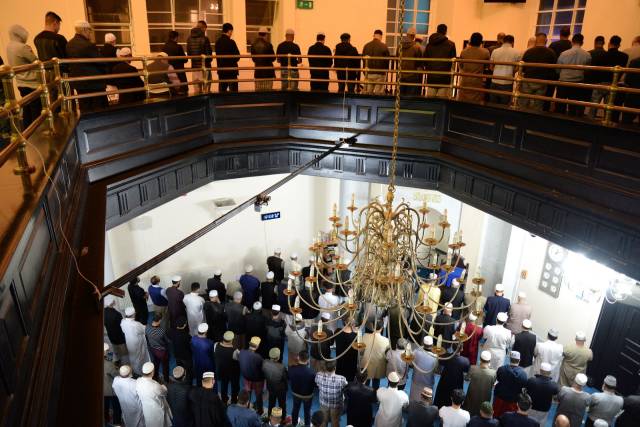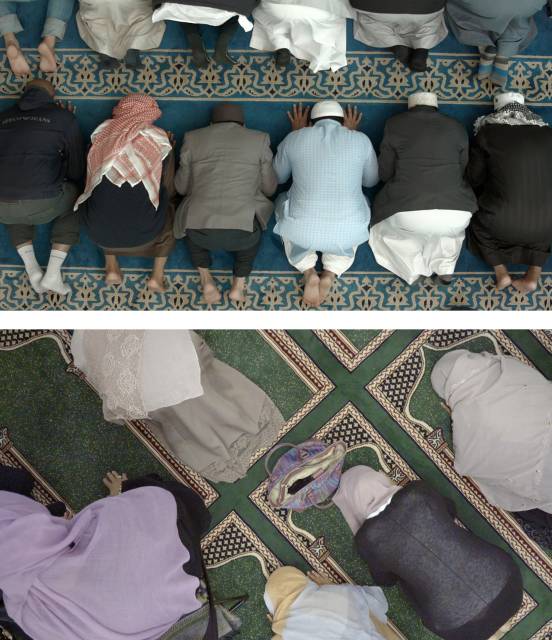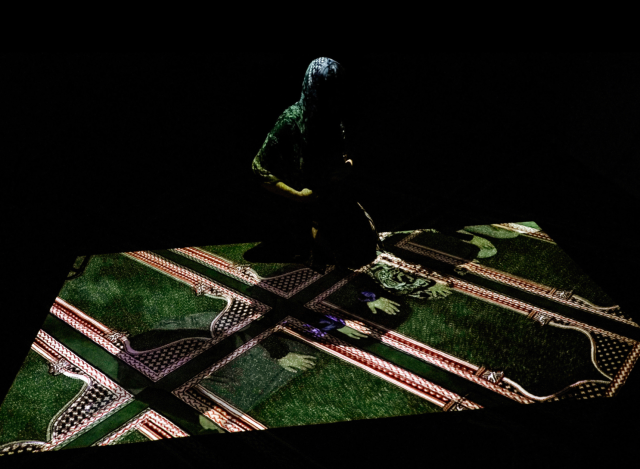Project framework: context, research questions, summary of research insights
Assembly is a series of site-specific installations that perform Muslim congregational prayer, comprising of 1:1 scaled moving floor projections with surround sound. The project uses motorised filming rigs to record the religious practices taking place in each mosque. What is recorded and how it is recorded is determined by the community, informed by the social/religious rules of the site. The motorisation of the rig is an essential element as it enables the footage to be projected back into site in synchronised time and space. This filmic representation of the religious practice can then be ‘experienced’ in the architectural site, hosted by each community.
Context
Harrow Mosque was originally a pair of semi-detached 1930s houses; Brick Lane an 18th-century Huguenot chapel, then synagogue; Old Kent Road previously a pub. So is it architecture, religious belief or something less tangible that denotes a mosque? My research revolved around the notion that it is the act of prayer.
Assembly uses site-integrity a working methodology – a particular but original mode of site-specific practice that potentiates a dynamic exchange between site, artist, device, and community. Artistic devices articulate the material, architectural, social, religious, institutional discourses present in site acting as an interface, a dynamic network or system of exchange. In Assembly site-integrity re-presents recorded material back in the place it was filmed using a motorised rig, defining spatial position and context. This enables an exact transfer of scale and time as the image maps the architectural site. With Assembly, rather than simply produce a representation of Muslim prayer, the aim was a series of artworks, centred on the congregation, that convey a deeper, more multifaceted sense of the experience.
Key questions
1 How might an immersive, site-specific installation enhance self-awareness of Islamic worship?
2 Can artistic fieldwork play a part in connecting communities?
3 Would art performed in a mosque (rather than a gallery) be more meaningful for the congregation?
4 Can innovative/digital technologies capture, record, disseminate and preserve dynamic cultural heritage, particularly interior spaces and intangible cultural practices?
Summary of research insights
Assembly enhanced the congregation’s self-awareness of the act of worship. The project highlighted the social and architectural diversity of mosques in Britain, raising questions about social boundaries, while creating an opportunity for mosques to connect with the wider community.
| Creators | Marsh, J. |
|---|---|
| Description | Made in collaboration with the different mosque congregations, Assembly uses a programmed device mounted on a six-metre motorised rig. Gliding back and forth on the rig, the device is both “recorder” and “player”: at the end of a shoot, the camera is replaced by a projector and the “film” is ready for playback. The work does more than reproduce prayer: it also “performs” the social and religious structures of the site, making evocative use of 5.1 surround sound to create an uncanny experience. Mapped precisely to the mosque floor, the projected image of the carpet disappears into the real carpet. And the congregation, returning as observers, watch ghostly illusions of themselves at prayer. |
| Portfolio items | Site-integrity: a dynamic exchange between site, artist, device and audience |
| Assembly: Performing the materiality of Muslim prayer spaces | |
| 2021 Venice Architecture Biennale - Three British Mosques/Assembly | |
| British Mosques | |
| Year | 2020 |
| Publisher | University of Westminster |
| Web address (URL) | https://vimeo.com/showcase/8120594/ |
| Keywords | CREAM Portfolio |
| Digital Object Identifier (DOI) | https://doi.org/10.34737/v844y |


